The Kaltura Media Space referred to as My Media is a great place to manage media such as videos, still pictures, and audio clips. There is not limit on storage space and you can publish/share media to multiple place with just a few clicks. Media can be added to your My Media in various ways. Click the green buttons below to navigate this guide.
Note for users of screen readers: letters in parentheses in the instructions below refer to corresponding areas on example images. If you have any questions about these instructions, contact eLearning for assistance.
Upload
Kaltura lets you upload virtually any media file from your computer to your My Media. Watch the tutorial video or follow the guide below.
- To add video that is on your computer, access My Media, click Add New (A), and select Media Upload (B).

- Next, click + Choose a file to upload (C).

- Locate the desired media in your File Explorer or Finder and click Open (D).

- Add a Name (E), Description (F), and Tags (G). Tags assist you with locating your videos. You can tag it with the subject, various content, class, module, etc.
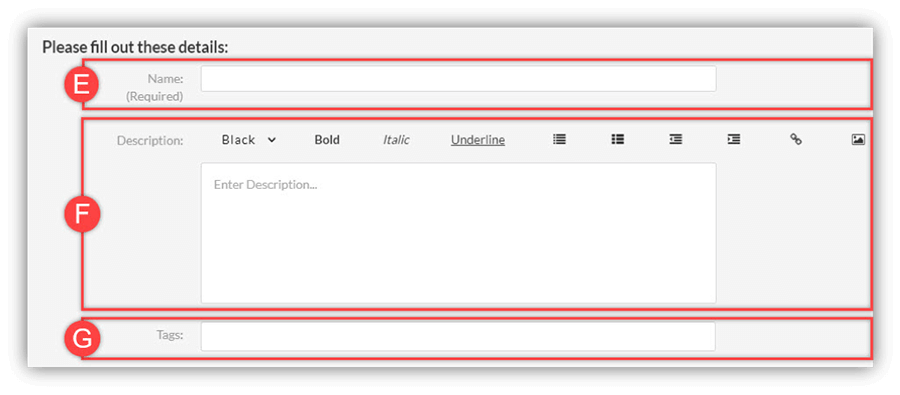
- Click Save (H) when you have finished. Click Go to Media (I) to see the media or Go to My Media (J) to return to all media that is in My Media.

Add a YouTube Video
The YouTube option incorporates external videos into your course media gallery so that students have the full context of your media resources. This option does not copy a YouTube video into your media repository, instead, it links out to the YouTube video and plays it in the Kaltura media player. This allows you to play videos without disruptive ads.
- Access My Media, click Add New (A) and the select YouTube (B).

- Enter the YouTube Video Link or URL (A) for the video and click Preview (B).
- The video will load and Play (C) on the right.
Note: If the video continues to load and does not play, click pause and then play again or fast forward. - The Name, Description, and relative Tags (D) should load automatically. You can modify these fields as desired.
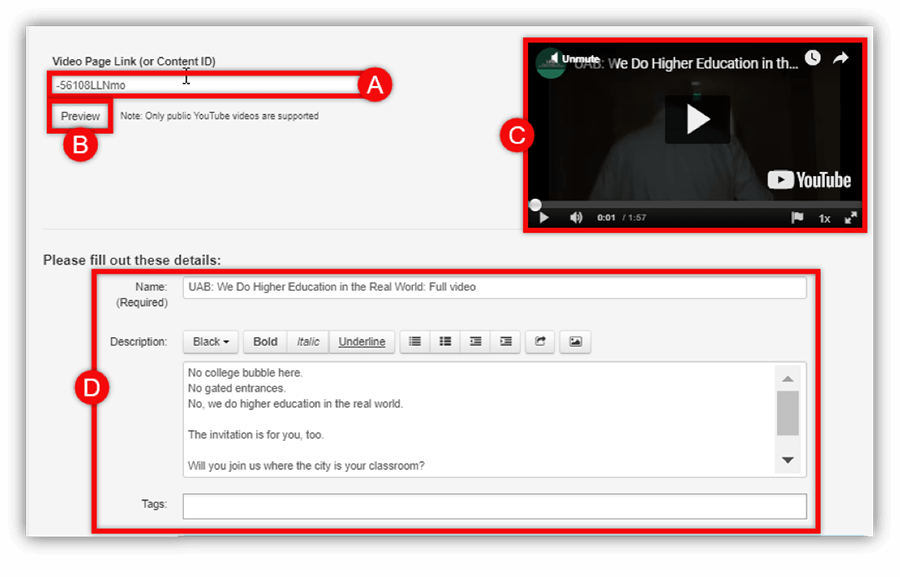
- Click Save (E) when you are done.

Express Capture
Express capture allows users create a video or audio recording quickly without having to download any software. This type of capture cannot capture your computer screen. Webcam recordings can also be done by choosing Kaltura Capture.
- To record a video from your webcam, access My Media, click Add New (A) and then Express Capture (B).
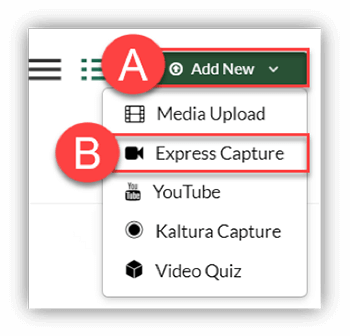
- Select Allow (C) to allow access to camera and microphone.
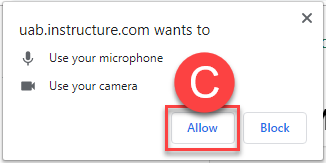
- Click the red Record (D) circle to start/stop recording.
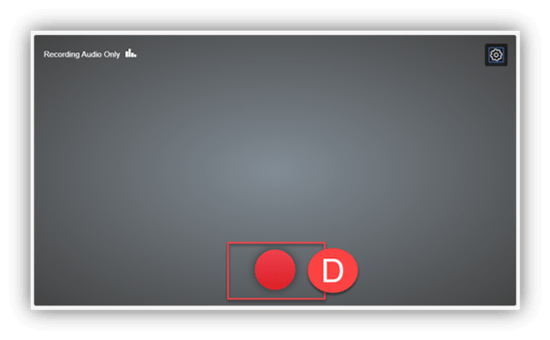
- Below the video, you have the ability to add the Name (required), Description, and Tags to the video. At the bottom, click Save (E).

Kaltura Capture
Kaltura Capture is a desktop recording software that has a simple user interface, requiring only one click to record, without complex setup or a lengthy learning curve. It can record your webcam, screen, microphone, or a combination of those options. Kaltura capture is supported both on Windows and Mac. For more information and details, see the full Kaltura Capture Guide.
- To record a presentation using Kaltura Capture, access My Media, click Add New (A) and then Kaltura Capture (B).
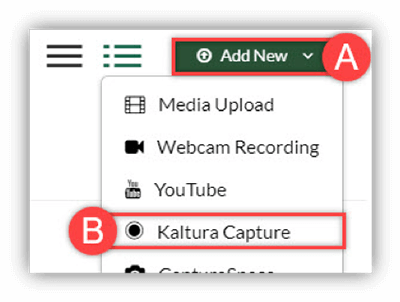
- If you are using Kaltura Capture for the first time, click the appropriate Download link (C) for your computer operating system. If you have already downloaded Kaltura Capture, skip to the next step (3).
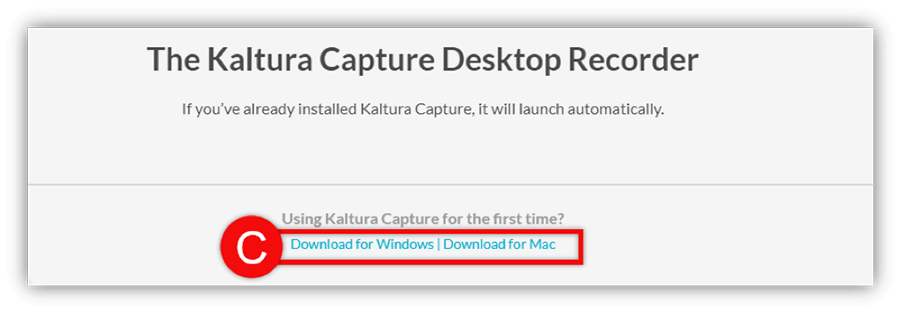
- The Kaltura Capture application should automatically launch on your computer.
Recording Media with Kaltura Capture
- Once Kaltura Capture is open, click the red Record (A) icon when all settings are as desired and you are ready to record. A 5 second count-down will appear and count down the start of the recording.

- Click the Stop (B) icon to stop the recording. A follow up menu will display to confirm this decision.
- Click the Pause/Record (C) icon to pause and resume the recording.
- Click the Cancel (D) icon to stop and discard the current recording.
- The recording menu displays the current Elapsed Time (E) of the recording.
- The Microphone (F) icon will be colored blue to signify microphone audio has been enabled for this recording. If the microphone icon is grey with a strike through it, this signifies microphone audio has been disabled for the current recording.
- Click the Minimize (G) icon to minimize the recorder into the taskbar/dock.
 Note: If the recording menu is not minimized, it will be visible in the recording video.
Note: If the recording menu is not minimized, it will be visible in the recording video. - Click the Pencil (H) icon to annotate on the screen being recorded.
- You can choose between the following Tools (I) when annotating: pencil, arrow stamp, text creator, object selector, and a cursor.
- You can choose which Color and Size (J) when using the annotation tools.
- 11. Click the Trash (K) icon to erase all annotations.
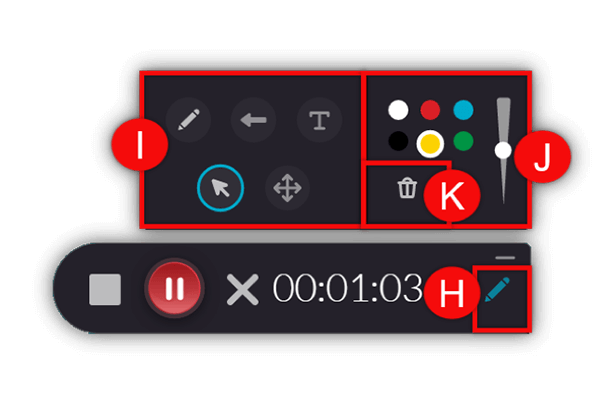
Saving and Uploading a Recording
Media recorded with Kaltura Capture needs to be uploaded when there is an internet connection. The uploaded media can be found in My Media either in Canvas or at mediaspace.uab.edu.
- Once you stop a recording, you will be directed to the Entry page (A).
- Click the Play (B) icon to preview the recording.
Note: Two screens will display vertical if you chose to record two video feeds (ex. Screen & Webcam). This view is just for previewing each feed separately. It will combine the two feeds in the Kaltura Interactive player once you upload the video. - Click the Sound (C) icon to Mute/Unmute the audio on the playback of the recording.
- Enter the desired Title, Description, and Tags (D) for the recording.
- Click Delete (E) to discard and delete the recording.
- Click Save and Upload (F) to save the information and upload the recording to your My Media.
- Click Save (G) to save the recording and information and upload at another time (for offline use). For more information and details, see the full Kaltura Capture Guide here.
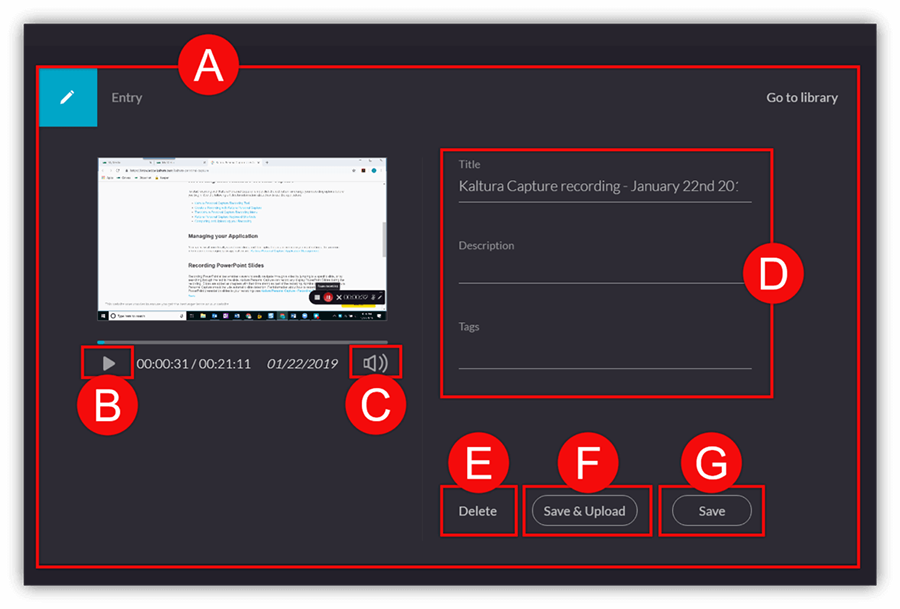
Link Zoom Recordings to Kaltura
Zoom meetings/webinars recorded to the cloud are automatically uploaded to the user's Kaltura (My Media) account.
Note: Please contact eLearning if Zoom meetings recorded to the cloud do not display in your My Media account (Kaltura).
Click the button below below to see how to record meetings to the cloud so that they show up in My Media.